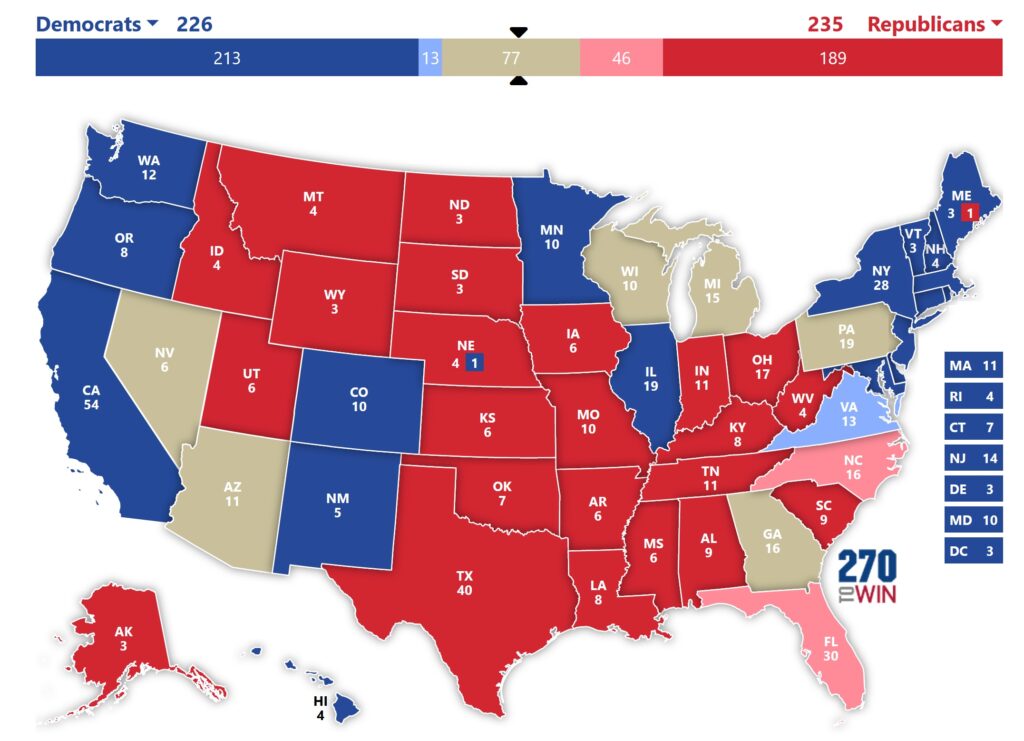To complete my snapshot look at the 2024 elections, here’s my current and still-too-early take on the Presidential election. [No, you don’t need to point out that this isn’t really my third take on the topic. But go ahead and send the email if it makes you feel better.]
My Electoral College projections don’t look much like what you’re reading elsewhere. While professional political pundits have cleaner access to more and better data than I can painstakingly pull and normalize from numerous public sources in weird formats, most seems to overweight their own omniscient opinions and the results of questionable polls.
Could I be dead wrong while the pundits are universally brilliant? Absolutely. But until the data tells me something else, I’m going with what I have.
Here’s my model’s current take:
For this round, my model says that 41 states aren’t at all in-play, leaving only nine swing states worth following. Of those nine, one state leans Democratic, two states lean Republican, and only six states are true toss-ups. While the pundit class might have Democrats contemplating that Canadian citizenship, my analysis says the Presidential election is pretty much a toss-up at the moment. Frankly, I’m not sure I understand how that could be a huge surprise to anyone.
I’ll dig into each state as things progress, but here’s a few general observations that are applicable across the board:
- Realignment of Electoral College votes between the states for 2024 tilted the math slightly in favor of the GOP. Demographic changes in swing states, however, slightly favors Democrats.
- The GOP does start with a better hand than Democrats. By my math, considering only the six toss-up states as being truly winnable by either party, Republicans have 14 paths to 270 Electoral votes; Democrats have 10 paths.
- Third-party candidates – specifically Kennedy and Stein – could have impacts in all nine swing states. It’s just too soon to tell how big those impacts will be and which major party loses more votes to third-parties in each state. The only given is that these races all look tight, implying a high probability of a third-party spoiler in multiple states.
- The Biden campaign and the DNC should continue to have a major cash advantage… particularly since much of the RNC’s money will apparently be paying for lawyers.
- The GOP’s vice-presidential choice could have an impact. If Republicans were smart, they’d pick someone that could deliver a swing state all by themselves and then simply park them there for the duration of the general election. Fortunately, the Orange Guy doesn’t think he needs help, and he could well pick a non-factor sycophant.
- The Orange Guy’s legal issues could have an impact in the swing states. Unfortunately, it appears that the NYC fraud case is the one most likely to resolve before the election – and that’s the weakest of all the cases. A rogue Florida judge and the U.S. Supreme Court have effectively delayed everything else.
- The status of the wars in Ukraine and in the Middle East could have an impact, but it’s unclear who benefits from a political standpoint. I’m pleasantly surprised that neither party seems to know how to turn out war votes.
- Women voters could again be a decisive factor. Abortion – rebranded as women’s rights – could be a winning issue for Democrats. Related ballot initiatives in Florida, Arizona, and Nevada could help deliver Democratic votes.
- Younger voters could again have a huge impact. While they pay almost no attention this early in the game, they tend to eventually vote Democratic. However, Democrats need to pay serious attention to their concerns. The GOP doesn’t need to actually win their votes; they just need young voters to stay home or vote for Stein.
